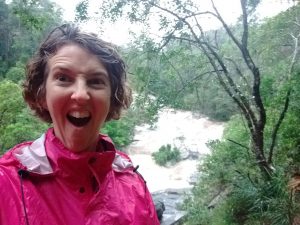Author Cristy Burne shares her top six survival techniques for touring authors.
touring authors.
So, it’s been a while since you’ve been on tour. In this new-normal, COVID-19 world, we’ve all grown used to the comforts of home: skyping in your PJs, talking to yourself, not wearing pants.
If you’re like me, it’s been a while since you’ve packed your Meet-The-Author bags to head into the [Big] Wide World.
Well, that’s about to change. This month I have a new book out (YAY!!!), and that means, COVID-19 lockdowns permitting, I may need to actually leave the house.
The book, Beneath the Trees, is a junior fiction adventure about teamwork, family and survival.
It’s based on the true story of a 2019 hike my family went on in Eungella National Park, Queensland. A hike I’m really glad we all survived! (Spoiler alert?)
Eungella is one of the best places in the world to see wild platypus, and that’s how everything really started … In the book, Cam and her little sister, Sophie, are looking forward to seeing a platypus, but when they finally spot one, something is wrong.
And then things just get worse. Soon they’re lost in the rainforest with their bossy older cousin, Jack. And they need all their resilience and courage to survive …
Just like you’ll need when you step out the front door on your next author tour.
So, because I’ve been thinking loads about survival, I’ve written up a list of top tips totally recommended if you want to make it through your next author tour alive …
- Find water
Dehydration leads to headaches, lethargy and hallucinations. Only one of these things will serve your career as a children’s writer. So it’s essential you secure a source of water early. Your voice will last loads longer if you’re sipping all day. Also, your brain needs water for proper functioning. Just saying.
Score additional points if you bring along your own reusable bottle.
- Signal to rescuers
If you’re drowning, not waving, you have an issue with communication.
If you’re an author on tour, it’s essential that you master the basic skills of effective signalling. Personally, I practise survival signalling every day, before I even leave the house. Techniques such as ‘I’d love a flat white, please’ may just save your life.
- Navigate to safety
We all get lost at some stage. I usually get lost on the way to the venue. Or on the way home from the venue. Or on the way to the bathroom at the venue.
The point is, if you find you’re losing your way, don’t panic. Just pause, get your bearings, and then strike out in a better direction. If you get lost onstage, the pause is your friend. It’s a survival tool you can use. Any. Time.
- Build a shelter
Protect yourself from sweltering heat, bitter cold, buckets of rain and billions of fans by ensuring you have shelter. This could take the form of a green room, staff room, hotel room, even the inside of your car. It’s way more fun if you actually build your shelter, so feel free to use library furniture, cushions, cardboard boxes and BYO mattress.
- Pack basic medical supplies
Throat lozenges, headache tablets, dark chocolate, instant coffee. Your melt-down bag should provide a strong sense of safety. Whether you’re suffering from a blister, bruised ego, or muscle cramp from signing so many books, packing some basic emergency supplies is always a good idea. Include a second thumb drive. And a second shirt.
- Make fire
Fire helps us cook, keeps us warm, and burns inside our souls for the rest of our lives.
Fire drives us forward, even when our slides don’t work or there’s an unexpected evacuation drill.
As children’s authors, our job is to start fires. A spark here, a spark there. Starting fires is the reason I get out of bed in the morning. It’s what drives me out of my front door. So make books, find your pants, and practise these survival techniques. Let’s start a fire in the hearts of children everywhere.
Cristy Burne’s new book, Beneath the Trees (Fremantle Press), is available from all good bookstores and online. It’s one of a trio of junior outdoor adventure stories that includes To the Lighthouse and Off the Track.
Thanks for visiting, Cristy.. You can find out more about Cristy at her website.

